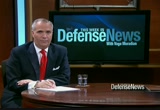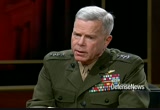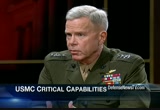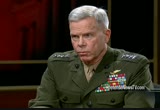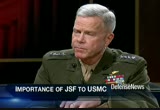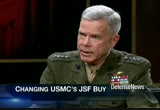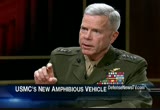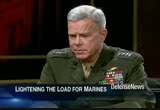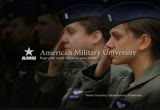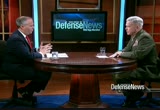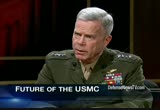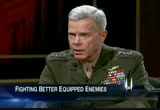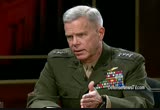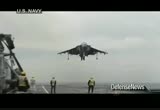tv This Week in Defense CBS July 31, 2011 11:00am-11:30am EDT
11:02 am
welcome to this week in defense news. i'm vago muradian. for more than 235 years the united states marine corp has been americas elite naval force but for the past decade the marines have played a critical role in iraq. they added 30,000 marines to leten the -- lighten the load on the force. the ability to conduct large- scale amphibious operations in the face of stiff enemy opposition. the expeditionary finding vehicle was canceled plus the so-called forced entry mission survived.
11:03 am
now as budget cuts loom, 15,000 marines will be reduced and there is cancellations, including the joint strike fighter. here to talk about this is general jamison amyous and the first aviator to hold this post. how much longer can you sustain the operations you have in afghanistan? >> we spent a long time thinking about that. i think we can sustain it for -- i hesitate to say indefinitely, but for quite a while. our forces are -- some of them are one to two. our in fantry is less than that right now. but the morale is commensurate with the good feeling that marines have about what they are doing and they feel that what they are doing is important. as long as that is the case and they are being supported back home, we can continue to sustain this. >> marines in one form or another have been in afghanistan since 2001.
11:04 am
what are some of the more recent lessons that you have learned from the latest push? >> first of all, we took a lot of lessons out of iraq. not everything translated from iraq and afghanistan but a lot of it did. the importance of culture and tribal chiefs. in iraq it was the sheikhs but here it's the tribal chiefs and who the decision-makers are in the tribe. protecting the people is important. understanding the importance of training the afghan national army and police and helping the people establish their own local rule. those are the lessons we took out of iraq and they apply to afghanistan. >> and are you comfortable with the progress made so far? >> i am. and i think we have every reason to be optimistic. i can speak about helmand province where the marines are and we have other nations along the side of us, but i'm encourage by what is going on
11:05 am
there. >> let me take you to a learning question. lessons are being learned on a daily and hourly field, and even into the nuances as that battlefield ebbs and flows, there have been set backs with karzai's half brother being killed, the governor of kandahar being killed, how quickly are you taking some of the lessons that you are harvesting from the field and getting into the hands of the predeployment force? >> it's almost overnight. we have marine corp on the grounds there, 12 of them, they are out with the units. and what happens is tactics and techniques, things change and the way the enemy reacts and to include the ied's or as soon as that comes in, that is harvested back at the camp and it comes almost instantaneously overnight back into 29 palms. it comes to quantico and then those things that are applicable that are urgent, we put to 29 palms and the training now, they turn it
11:06 am
overnight and they will incorporate that into their training the next day. >> since we're talking about lessons learned, let me take you to the libya operation really quickly. ordinary for an operation like that the navy would have made one aircrafta carriers available, but instead it was uss keer sarge that responded, flying to mission as day over the early part of the vision and formed a fairly potent strike force. what were some of the lessons learned in that operation and what does it tell us about how we should be using these big amphibious ships in the future? >> i think it is a testimony to the big deck amphibians. right now we have 11. navy has 11 cbn aircraft carriers, so our nation at large has 22 large deck what i call capital ships. >> power projection ships? >> power projection ships. ships that can influence the action. so we have 11 -- excuse me, 22
11:07 am
now and each one of them have fixed wing airplanes on them and i think the key lesson for everybody is the value of having 11 -- excuse me 22 versus 11, should we go down the road somewhere and we end up losing our stonewall capabilities, then our nations instead of having 22 ships where you can fly fixed wings, you only have 11 and our capability will be half so i think that's a powerful lesson. >> that's something we'll discuss in the next segment. but i want to take you to the budget and to the capability review that is ongoing. there was a number of $400 billion to be cut over a dozen years and folks are sayings that overcome by events that there is a lot of debt negotiation talk and numbers as high as a trillion dollars to be cut from defense spending over the coming years. what are the capabilities that your arguing are absolutely integral to the future of the corp and what can the carps trade away? >> we have to have a discussion about what it is -- a discussion at the senior level, what it is we want our
11:08 am
department of defense to do, our neri marine corp, air force and army, what do they need to do for the nation. that discussion is going on right now with the strategy review within the department of defense. so that's critical. once that decision is made, and then the senior leadership of our nation says, yes, this is what we want our service to do and then you come down to the individual service. in our case, we look at ourself as the crisis response force. we are america's force that you call tonight and if you want it done tonight you call the marine corp. >> that can flex up and down. >> it does. it's like a balloon, you can blow it up or let the air out but it's a high state of readiness. there is some duplication, but where there is no duplication is its ability to respond to today's crisis with today's force today. not tomorrow, not next week, but today. so that force needs to have a high state of radius. when we talk about trading things off, one of the things we didn't do as a nation, it seems to me, is have all of our
11:09 am
forces at some moderate level of readiness because that's an affordable. maybe we ought to have a force that is at a high state, because when things happen -- when sear sarge pulled into the med ten arian, it didn't have the landing team on board because they were in afghanistan on the ground. and in a matter of 20 hours notice, we notified a battalion at camp lejeune and they were loaded up and met it. and so that's today. that's 35 stonewall for the very reasons we talked about. we'll lose the capability for our capital ships to have fixed wing strike aircraft. the f-35 b is going to be more capable. it will be information dominant, it's going to be electronic warfare strike, it will have all of those capabilities and we'll be down to 11 large deck ships. >> where do you feel you can do
11:10 am
a lot of trading off on. >> there is not a lot of fat in the marine corp. and through that 7.8% we provide the ground combat forces and 5% of the fighter aircraft and 19% of rotary wing. so if you look at all statistics in the marine corps, officers from enlisted, general officers to troops, cost of the marine versus single marine versus -- we're about as lean as you can go. so there is not a lot of fat, vago. >> you are taking 15,000 marines out of the force but there are those that say you will have to take many more marines out of the force. are you going to end up going back to under 172,000 which is where you were in 9/11. >> i doubt it. i don't think so. i'm not planning on it. we have nine months of rigorous analysis into the drawdown that secretary gates challenged the marine corps to do in september. we spent the last four months and 7 months of they are.
11:11 am
11:12 am
11:13 am
the short takeoff and vertical landings that we discussed earlier, you made a good case on why that capability was important for the marine corps, but there is still critics who are very focused on getting rid of that version of the aircraft. and saying that what it contributes is going to prove ultimately too expensive and there are engineering challenges and supporters say the flight tests are going well. what are the stakes if the program is canceled for marine corps aviation? >> i think it's more than just for the marine corps aviation. i think the question is what are the stakes to the nation? we go back to our earlier discussion about you're not going to have 11 capital ships with fixed wing airplanes, you cannot do with sear sarge just did. you'll have helicopters and tilt rotors but not have the strike capability, that interdiction capability off of 11 cap shall ships. so far our nation has to answer is the juice worth the squeeze. and the second thing is we'll
11:14 am
lose the ability to be expeditionary. when i was the wing commander in iraq in 2003 we flew our carriers off highways and flew them off of bombed out runways. every runway was created by hussein so we threw them off taxi ways and runways. >> as the aircraft was envisioned to be able to do? >> exactly. so we'll lose that. it's not a matter of we're going to plan on operating in an expeditionary environment like everybody else will operate a standard fixed wing, in the world we looked at the 3,000-foot runways. there is ten times as many 3,000-foot runways in the world as there are 8,000-foot runways. think about that. so when you start talking about where marines go and how they do business, we need to be able to operate in an expeditionary environment or we'll lose that capability. >> but you also made the decision early to acquire five squadrons of the sea version naval variant and there are
11:15 am
those that said the marine corps has for 15 years that everything we buy should take off and land vertically and some say that rerodes the case for the stovall aircraft. >> i don't think it does. i was one of the advocates of the force and in a perfect world, i would be today. but i'm also -- i've also spend time under roosevelt so i was part of the attack and i'm a big believer in it. so the navy needs marines to operate that and we agree on that and as so as the f-35 b program was slowed down last fall bisect gates it just seemed time to go ahead and say, okay, we'll buy five squadrons of c's, we'll be the integrating squadrons and we'll have marines flying those on naval aircraft carriers and that is the end of the buy. we're going to buy 80 airplanes, the 10 per squadron and plus what we call pipeline
11:16 am
airplanes, but that's it. and all of the rest of them are stonewall. so there wasn't a break in the dam or a cheek in the arm, it was very purposeful decision on my part based on a guy that understands the value of attack integration and flying off of aircraft carriers. >> let me take you through the question of the expeditionary finding vehicle. the expedition was canceled. you expect to drive the new physical, the son of it, the new amphibious vehicle. what are the capabilities of the new vehicle going to be? >> we had rough requirements drafted and what we're doing right now is we're doing an analysis. analysis takes a year and i told them let's go six months. i don't want anything shortened, i want you to work harder and faster and work on the weekends and christmas, that's fine with me, we want to get on with this thing. i don't want the acquisition time line laid out. we are in the middle of that. at the end of that there will be decisions based on the
11:17 am
requirements and what the results of the aoa are and we'll put out a request for proposal and industry. >> do you know how different it will be at this point? >> i do. i think it will still carry 13 combat loaded marines and still have a gun on it, not sure what size, still have situational awareness command and control but it will go less speed. it won't go 25-30 knots, our goal is somewhere between 12-15 knots. and it will have a good environmental system on it. >> so it's not as miserable as it is for folks in the back of a current acamtrak. >> it's tough back there and we want to make it easier for them. >> speaking of easier, one of the priorities was to lighten the load on marines. a mutual friend of ours said 150 pounds of the lightest weight gear is still 150 pounds, what are you doing to lighten the load? >> they are small incremental
11:18 am
changes but the model weighs 36- 37 pounds and we've modified that down to 3 pounds. and now we are in higher altitudes we've taken a version of that and taken what we call the plate carrier where we take the plates in the front and on the side and back and we wear that like a vest. and that's cut the load of that thing down by probably a third. so we've done that. we're just feeling now the infantry assault rifle. >> it is significant. >> it could be the replacement for the m 2-49, it weighs half of that. so these are the things we're doing to truly lighten the load and get it below 150 pounds so it's something marines can operate. >> let me ask you in the 30 seconds or so left about the joint light tactical vehicle. it was a joint program between the army and marine corps who developed a replacement for the
11:19 am
humvee and the challenge is the vehicle that you have now is too heavy and costly for your needs. there is this chimney technology that is being tested now bydaffo to allow a 10-20 vehicle a survive ability, is that the answer for future lighter marine vehicles? >> i think it could be. we were engaged in that before christmas of last year. we are looking at several technologies out there and there are encouraging ones there. and that is one of them. but the vehicle needs to be light enough so we can put it on ships, put it on airplanes and be able to maneuver around with it and not get stuck in someplace like the sand
11:22 am
amos, commandant of the u.s. marine corps. what is the future of the marine corps and how has that vision been shaped over the past decade? >> first of all, i think we need to get back to kind of our combined arms. and it's not the coin that we've been doing. it's been very important and i think it's a part of the future based on the future security environment. the marine corps is operating in nasty areas around the world, lawless, ungoverned, urban areas, that's where the nation will take its marines and use them. so the vision is to have a force that is educated, trained, equipped to be able to operate in a dispursed environment and a thorny neighborhood. there is going to be issued with crime and all kinds of things in the future. so the vision is to have an agile force that is escapable so you can make it large or
11:23 am
small and that is adaptable and is forward deployed. >> and that's because of the in creasing importance of the pacific? >> it is. i'll tell you what, vago, the pacific right now is -- first of all, it's the largest sea mass in any of the combatant commanders maureens right now. we know the importance of china is growing. we have a lot of time. marines have spent a lot of time in the pacific, and from a lot of rich history back to world war 22. ii. so if your talking about war prevention, if you are talking about engagement, building trust and confidence with your allies, the marines are the force to do that in the pacific. and i want to -- my goal would be to reorient the marine corps back into the pacific once we come out of afghanistan. >> let me ask you about one of the big challenges, the forced
11:24 am
entry mission. there is a proliferation of munitions, hezbollah have missiles that keep ships at bay and that's why secretary gates was questioning whether the forced entry mission has a future. how do you operate in an environment where bad guys will have night vision equipment and greater intercon activity and how do you come up with that? >> we don't want to do the assault in that environment. in other words being able to do the assault someplace else. that's maneuver warfare by definition. so we want to go where the enemy is not. not always the situation. so we want to bring all of the elements of our national power to bear. and that sounds like a platity todd but there is a lot of capabilities, the air force and the army and navy bringing to bear here, help our agency partners shape the battlefield. and it may not be that you see the marines come in on d-minus
11:25 am
whatever like we saw in the pacific, maybe a little bit later on after we've had the opportunity to shape the battlefield. so i'm not fearful that we will not be able to come in. we will be able to come in. we will be able to prevail because not only just the weapons, but also the capabilities of our nations. >> we have a little bit left than an minute, but you were an interrupted service marines. 26s months off after a very long deployment to spend time with your family and civilian wasn't your cup of tea so you went back into the marine corps and most people won't make colonel let alone commandant. so in the 0 seconds left, do we need to think differently about the service in the future. >> i think we need to think about how we educate those marines and educational satisfaction while their in the corps. i think the recruiting part is robust and i know we're at war now and so that's the encouragement but the fact of the matter is i think that the
11:26 am
11:27 am
as washington looks to cut defense spending, it's no surprise the biggest defense program, the joint strike fighter, is being targeted. and of the three versions of the jet, the heat is rising on the short takeoff and vertical landing version of the plane which was placed on probation last year by former defense secretary gates for cost increases and delays. the plane is the hardest of the three to develop. but killing it would rob the nation of what would might be the most useful incarnation of
11:28 am
the aircraft. would replace the harrier jump jet, now the only aircraft able to operate from the amphibious ship. the navy can use more for less. and the harrier can operate with stealth and better performance, making the am fibons. it can also carry helicopters and 1600 marines and their gear. six harriers flying from kearsarge performed early in the libya operation. killing it might save some money but come at a serious cost. the ability to put high-end power anywhere it's needed. thanks for joining us for this week in defense news. and before we
138 Views
IN COLLECTIONS
WUSA (CBS) Television Archive
Television Archive  Television Archive News Search Service
Television Archive News Search Service 
Uploaded by TV Archive on

 Live Music Archive
Live Music Archive Librivox Free Audio
Librivox Free Audio Metropolitan Museum
Metropolitan Museum Cleveland Museum of Art
Cleveland Museum of Art Internet Arcade
Internet Arcade Console Living Room
Console Living Room Books to Borrow
Books to Borrow Open Library
Open Library TV News
TV News Understanding 9/11
Understanding 9/11

